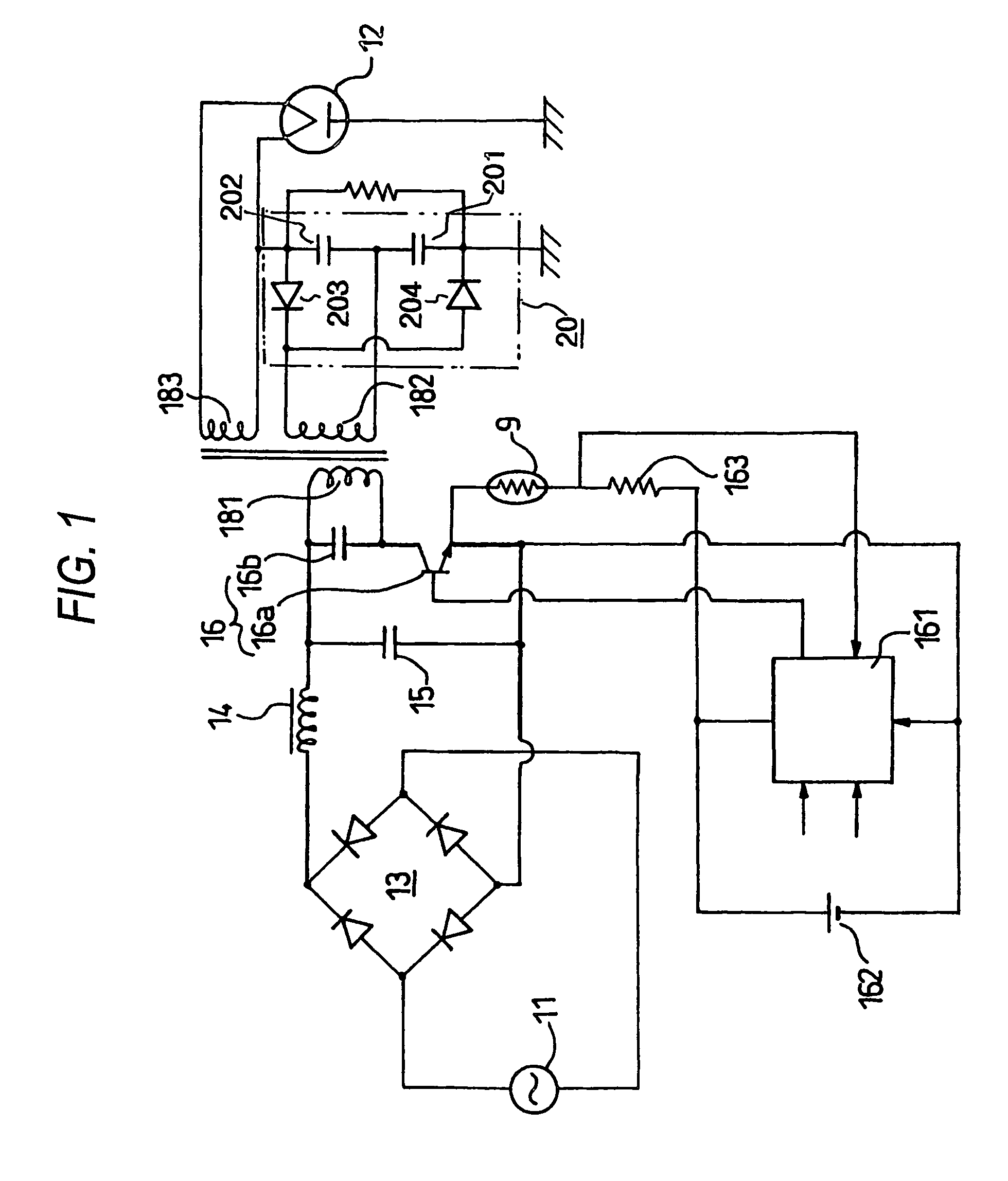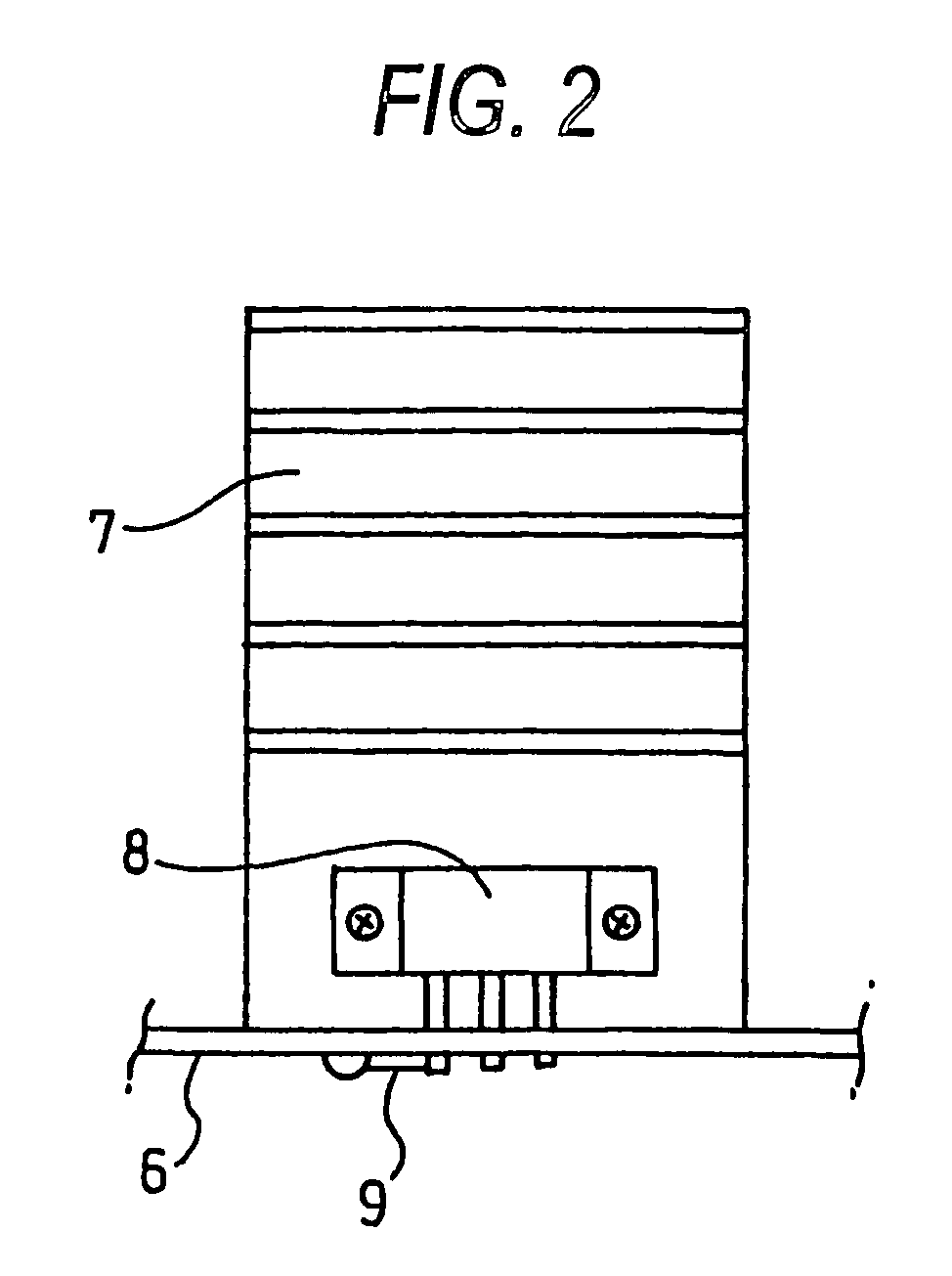High-frequency dielectric heating device and printed board with thermistor
a dielectric heating device and dielectric heating technology, applied in the field of high-frequency dielectric heating, can solve the problems of increasing the number of steps, increasing the cost, and the cooling fan to be locked, and achieve the effect of easy breakag
- Summary
- Abstract
- Description
- Claims
- Application Information
AI Technical Summary
Benefits of technology
Problems solved by technology
Method used
Image
Examples
first embodiment
[0078]FIG. 3 are diagrams illustrating a first power-down control system according to the present invention, wherein FIG. 3A is a circuit diagram and FIG. 3B is a diagram illustrating the operation of a comparator.
[0079]In FIG. 3A, a terminal (A) which is one of the two input terminals of a comparator CO1 receives a potential at a point P3 at where the collector voltage of the IGBT is divided by the voltage-dividing resistors R3 and R4, and the other terminal (C) receives 3 V since the switch S1 at the start is on the side of the terminal a. After the magnetron is heated and assumes a steady state, the change-over switch S1 is changed over to the side of the terminal b, and the terminal (C) receives a potential at a point Pc at where the voltage Vcc is divided by the voltage-dividing resistor R1 and by the thermistor T1 as described earlier.
[0080]Here, what makes a difference from the start control circuit of FIG. 10A is that the potential at the point Pc at where the voltage Vcc is...
second embodiment
[0082]FIGS. 4A and 4B are diagrams illustrating a second power-down control system according to the invention, wherein FIG. 4A is a circuit diagram and FIG. 4B is a diagram illustrating the operation of a comparator.
[0083]In the second system, the circuit for limiting the collector voltage is not operated when the detection temperature of the thermistor is smaller than a predetermined value. As the predetermined value is exceeded, however, the circuit is operated to limit the collector voltage. Here, a feature resides in that the above start control circuit of FIG. 10A is utilized to limit the collector voltage.
[0084]In FIG. 4A, a terminal (A) which is one of the two input terminals of a comparator CO1 receives a potential at a point P3 at where the collector voltage of the IGBT is divided by the voltage-dividing resistors R3 and R4, and the other terminal (D) receives 3 V since the switch S1 at the start is on the side of the terminal a. After the magnetron is heated to assume a st...
third embodiment
[0087]FIGS. 5A and 5B are diagrams illustrating a third power-down control system according to the invention, wherein FIG. 5A is a circuit diagram and FIG. 5B is a diagram illustrating the operation of a comparator.
[0088]The third system is a modification of the control operation of the second system. When the detection temperature of the thermistor is further raised, the reference signal of 3 V used in the second system is lowered according to the temperature detected by the thermistor.
[0089]In FIG. 5A, the moving contacts K1 and K2 of the change-over switches S1 and S2 at start are contacted to the side of the terminals a, and a potential 3 V at a point P5 at where Vcc is divided by the resistors R5 and R6 is input to the one input terminal D of a comparator CO1.
[0090]At the start, further, the other input terminal A of the comparator CO1 receives a potential at a point P3 at where the collector voltage of the IGBT is divided by the resistors R3 and R4. When a potential across the...
PUM
 Login to View More
Login to View More Abstract
Description
Claims
Application Information
 Login to View More
Login to View More - R&D
- Intellectual Property
- Life Sciences
- Materials
- Tech Scout
- Unparalleled Data Quality
- Higher Quality Content
- 60% Fewer Hallucinations
Browse by: Latest US Patents, China's latest patents, Technical Efficacy Thesaurus, Application Domain, Technology Topic, Popular Technical Reports.
© 2025 PatSnap. All rights reserved.Legal|Privacy policy|Modern Slavery Act Transparency Statement|Sitemap|About US| Contact US: help@patsnap.com



